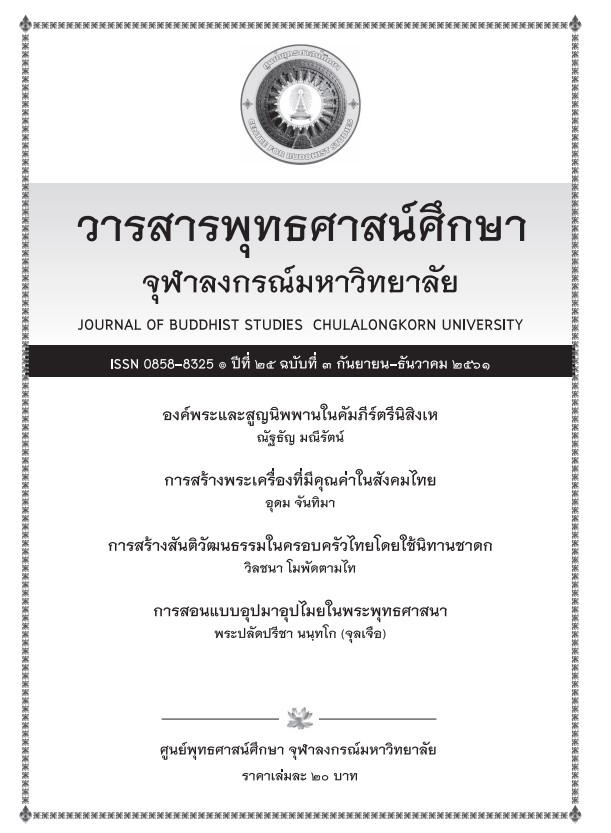Metaphorical Teachings in Buddhism
Keywords:
Metaphorical, teaching, BuddhismAbstract
Metaphorical teachings in Buddhism refer to the use of figures of speech to explain the Dhamma through two comparative principles – Dhammadhitthana and Puggaladhitthana. Dhammadhitthana is called Uppama which means abstract, whereas Puggaladhitthana is called Uppamai which means concrete objects. These kinds of teaching have enjoyed success in both mundane and transcendental levels, and is applicable at present in describing, preaching, and answer questions pertaining to Buddhism. This teaching can be found in 3 eras: during the Buddha’s lifetime, in early Buddhism, as well as in the Sangha era in Thai Buddhist society. The Lord Buddha employed this teaching method from the very beginning of Buddhism, and monks since the Buddha’s lifetime have used this method in the propagation of Buddhism until the present. During His lifetime, the Lord Buddha utilized metaphorical teachings by drawing comparisons between events or common knowledge in everyday life with the Dhamma. In early Buddhism, monks employed this method in their disputes over the Dhamma’s content in their propagation and protection of the teachings. In the Sangha era in Thai society, monks have used the metaphorical method in combination with examples, with supporting documents, through comparisons of the Dhamma with the teachings of other religions and philosophies, as well as with sociological, scientific, and psychological views. Monks would refer to words of the Buddha in the Tripitaka and use the metaphorical method to draw comparisons with present-day situations appropriate for the audience. This method is also used in the study of the Threefold Training, beginning from family stories to nirvana. It is also used in combination with rhetoric through both the Thai and Pali languages.
Downloads
References
ก. ข้อมูลปฐมภูมิ
มหาจุฬาลงกรณราชวิทยาลัย. พระไตรปิฎกภาษาบาลี ฉบับมหาจุฬาเตปิฏกํ, ๒๕๐๐ กรุงเทพมหานคร: โรงพิมพ์มหาจุฬาลงกรณราชวิทยาลัย, ๒๕๓๕.
________.พระไตรปิฎกภาษาไทยฉบับมหาจุฬาลงกรณราชวิทยาลัย. กรุงเทพมหานคร: โรงพิมพ์มหาจุฬาลงกรณราชวิทยาลัย, ๒๕๓๙.
________.อรรถกาแปลภาษาไทยฉบับมหาจุฬาลงกรณราชวิทยาลัย.กรุงเทพมหานคร: โรงพิมพ์มหาจุฬาลงกรณราชวิทยาลัย, ๒๕๕๓.
ข. ข้อมูลทุติยภูมิ
กองทุนผู้ให้แสงสว่าง. สุภัททานุสรณ์. กรุงเทพมหานคร: กองทุนผู้ให้แสงสว่าง, ๒๕๑๙.
ฝ่ายวิชาการ บริษัท สกายบุ๊กส์ จำกัด. พจนานุกรมไทย. พิมพ์ครั้งที่ ๑๔. ปทุมธานี: บริษัท สกายบุ๊กส์ จำกัด, ๒๕๕๗.
พระเทพเวที (ประยุทธ์ ปยุตฺโต). พจนานุกรมพุทธศาสน์ฉบับประมวลธรรม. พิมพ์ครั้งที่ ๑๐. กรุงเทพมหานคร: โรงพิมพ์บริษัทสื่อตะวันจำกัด, ๒๕๔๕.
พระธรรมปิฎก (ป.อ.ปยุตโต). กฐินสองที่สายใจธรรม. กรุงเทพมหานคร: สหธรรมิก, ๒๕๓๗.
พระพรหมคุณาภรณ์ (ป.อ.ปยุตโต). ปรัชญาการศึกษาของไทยภาคพุทธธรรม: แกนนำการศึกษา (ภาคต้นของหนังสือปรัชญาการศึกษาของไทย). กรุงเทพมหานคร: ผลิธัมม์, ๒๕๕๖.
_________. พจนานุกรมพุทธศาสน์ฉบับประมวลศัพท์. พิมพ์ครั้งที่ ๒๓. กรุงเทพมหานคร: สำนักพิมพ์ผลิธัมม์ในเครือบริษัทสำนักพิมพ์เพ็ทแอนโฮม จำกัด, ๒๕๕๘.
พระพรหมบัณฑิต (ประยูร ธมฺมจิตฺโต). พระพุทธศาสนากับวิทยาศาสตร์. พิมพ์ครั้งที่ ๓. กรุงเทพมหานคร: โรงพิมพ์มหาวิทยาลัยมหาจุฬาลงกรณราชวิทยาลัย, ๒๕๕๕.
พระโพธิญาณเถร (ชา สุภัทโท). เหมือนกับใจคล้ายกับจิต. พิมพ์ครั้งที่ ๗. กรุงเทพมหานคร : คิวพริ้นท์ แมเนจเม้นท์, ๒๕๔๖.
พระสิริมังคลาจารย์.มังคลัตถทีปนีแปล เล่ม ๑.กรุงเทพมหานคร: มหามกุฏราชวิทยาลัย, ๒๕๔๐.
พระสิริมังคลาจารย์.มังคลัตถทีปนีแปล เล่ม ๒.กรุงเทพมหานคร: มหามกุฎราชวิทยาลัย, ๒๕๔๓.
พระพุทธโฆสเถร. คัมภีร์วิสุทธิมรรค. พิมพ์ครั้งที่ ๑๐. แปลและเรียบเรียงโดยสมเด็จพระพุฒาจารย์ (อาจ อาสภมหาเถร). กรุงเทพมหานคร: ธนาเพรส, ๒๕๕๔.
เสฐียรพงษ์ วรรณปก. พุทธวิธีการสอนจากพระไตรปิฎก. กรุงเทพมหานคร: เพชรรุ่ง, ๒๕๔๐.
๒) วิทยานิพนธ์
พระธรรมกิตติวงศ์ (ทองดี สุรเตโช). ศัพท์วิเคราะห์. กรุงเทพมหานคร.สำนกพิมพ์เลี่ยงเชียง, ๒๕๕๐.
พระมหาวิสิษฐ์ ปญฺญาวฑฺฒโน. “การศึกษาเชิงวิเคราะห์เรื่องการอุปมากถาในมิลินทปัญหา.”วิทยานิพนธ์พุทธศาสตรมหาบัณฑิต. บัณฑิตวิทยาลัย: มหาวิทยาลัยมหาจุฬาลงกรณราชวิทยาลัย, ๒๕๔๕.
พระมหาสมพร อาภากโร. “การศึกษาอุปมาอุปไมยในคำสอนของพระโพธิญาณเถร.”วิทยานิพนธ์พุทธศาสตรมหาบัณฑิต. บัณฑิตวิทยาลัย: มหาวิทยาลัยมหาจุฬาลงกรณราชวิทยาลัย, ๒๕๔๘.
พระเมธีวรญาณ. “การศึกษาวิเคราะห์คัมภีร์ปรมัตถมัญชุสา.” วิทยานิพนธ์พุทธศาสตรดุษฎีบัณฑิตบัณฑิตวิทยาลัย: มหาวิทยาลัยมหาจุฬาลงกรณราชวิทยาลัย, ๒๕๔๕.
วศิน อินทสระ. อธิบายมิลินทปัญหา. กรุงเทพมหานคร : มหามกุฏราชวิทยาลัย, ๒๕๒๘.
Downloads
Published
How to Cite
Issue
Section
License
บทความที่ได้รับการตีพิมพ์เป็นลิขสิทธิ์ของศูนย์พุทธศาสน์ จุฬาลงกรณ์มหาวิทยาลัย
ข้อความที่ปรากฏในบทความแต่ละเรื่องในวารสารวิชาการเล่มนี้เป็นความคิดเห็นส่วนตัวของผู้เขียนแต่ละท่านไม่เกี่ยวข้องกับศูนย์พุทธศาสน์ จุฬาลงกรณ์มหาวิทยาลัย และคณาจารย์ท่านอื่นๆในมหาวิทยาลัยฯ แต่อย่างใด ความรับผิดชอบองค์ประกอบทั้งหมดของบทความแต่ละเรื่องเป็นของผู้เขียนแต่ละท่าน หากมีความผิดพลาดใดๆ ผู้เขียนแต่ละท่านจะรับผิดชอบบทความของตนเองแต่ผู้เดียว






